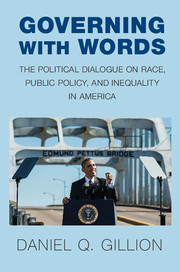Book contents
- Frontmatter
- Contents
- List of Figures
- List of Tables
- Acknowledgments
- Introduction
- 1 Discursive Governance: Toward a Holistic Approach to Understanding a Dialogue on Race in Government
- 2 Measuring the Political Dialogue on Race
- PART I Societal Reception to a Dialogue on Race
- PART II Political Institutions and a Dialogue on Race
- Conclusion: A Place for a Racial Dialogue in an Aspiring Post-Racial Society
- Appendix A Defining and Measuring Race-Related Statements
- Appendix B Study Description and Coding across Chapters
- Appendix C Wharton Behavioral Lab Experiments and the National Experiment
- Appendix D Method for Assessing the Overlap of Presidential Discussion and Minority Magazine Articles: Text Reuse (Plagiarism Analysis)
- References
- Index
2 - Measuring the Political Dialogue on Race
Published online by Cambridge University Press: 05 April 2016
- Frontmatter
- Contents
- List of Figures
- List of Tables
- Acknowledgments
- Introduction
- 1 Discursive Governance: Toward a Holistic Approach to Understanding a Dialogue on Race in Government
- 2 Measuring the Political Dialogue on Race
- PART I Societal Reception to a Dialogue on Race
- PART II Political Institutions and a Dialogue on Race
- Conclusion: A Place for a Racial Dialogue in an Aspiring Post-Racial Society
- Appendix A Defining and Measuring Race-Related Statements
- Appendix B Study Description and Coding across Chapters
- Appendix C Wharton Behavioral Lab Experiments and the National Experiment
- Appendix D Method for Assessing the Overlap of Presidential Discussion and Minority Magazine Articles: Text Reuse (Plagiarism Analysis)
- References
- Index
Summary
In Chapter 1, I established a theoretical foundation for understanding the multiple influences that a dialogue on race has on public policy as well as societal norms. I argued that the political discourse on race incorporates the minority experience into the political agenda for federal government officials and increases the importance of political messages for the minority community. This chapter introduces a new measure of a racial dialogue that will serve as a base from which to explore these theoretical arguments. The measure of a racial dialogue captures everyday conversations taking place by federal politicians in Congress and in the Oval Office. It then employs this measure to consider the geographical and temporal distribution of a racial dialogue in government. Ironically, over the period of study, while the number of racial and ethnic minority politicians increased in federal government, the discourse on race declined. The chapter explores this declining trend with a historical assessment of politicians’ discussion of race, focusing on presidential dialogue in a “post-racial” society. The chapter concludes with a discussion of the political consequences that may arise in the midst of a muted discourse on race.
EXISTING APPROACHES TO MEASURING THE POLITICAL DISCOURSE ON RACE
There is a disconnect between theories of a racial dialogue in government and empirical measures of politicians’ references to race. While theories of a dialogue on race have been richly informed, argued, and debated, scholarship on tracking and measuring this dialogue is dwarfed in comparison. Only recently have scholars attempted to measure the political discourse on race in government. Yet in this nascent stage of measuring the dialogue on race, scholars have produced multiple definitions of what constitutes a racial statement and numerous ways to quantify the occurrence of these remarks. Arguably one of the most widely used approaches to illustrate that a racial discourse is taking place in government is through historical case studies. Here, scholars have woven together specific incidents of a president or congressional leader speaking about race in order to construct a larger narrative of a unique dialogue. Scholars might also offer a series of quotes that relate to race in order to show patterns of discussion.
Scholarship on the discourse on race has also taken a very in-depth approach to understanding the context and syntax of unique speeches.
- Type
- Chapter
- Information
- Governing with WordsThe Political Dialogue on Race, Public Policy, and Inequality in America, pp. 30 - 50Publisher: Cambridge University PressPrint publication year: 2016

